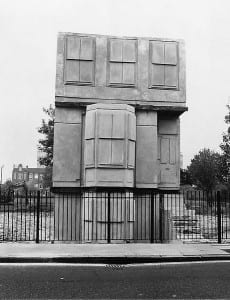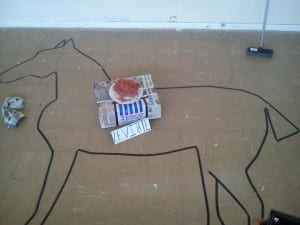Our papering of the weighing room bares similarities to artist Rachel Whiteread’s sculptures of negative space. She fills the unused space around domestic objects with all kinds of material to make casts and then removes the object inside. They are ghosts of interior spaces or, if you like, positive impressions of negative spaces (( Rachel Whiteread,EMBANKMENT:About, Tate,http://www.tate.org.uk/whats-on/tate-modern/exhibition/unilever-series-rachel-whiteread-embankment/rachel-whiteread, Accessed 4/5/2013)) The focus of her work is to concentrate on the absence of life within these spaces and the memories they use to hold. As critic Kathryn Chadason comments on her work ” Revealing the space we cannot define” (( Chadason, Kathryn, Sculpture “Negative Space with Rachel Whiteread”, http://trendland.com/negative-space-with-rachel-whiteread/, Accessed 3/5/2013)) In response to this our aim as a group was to work on revealing the Grandstand by helping to restore its lost/absent definition. In particular her sculpture cast House (1993) (( Augustine, Luhring “Rachel Whiteread Bio” http://www.luhringaugustine.com/artists/rachel-whiteread/# ,Accessed 3/5/2013)) a uninhabitable east end London Victorian town house. A large scale project which was filled with liquid concrete to create the mold then knocked down on the inside once set. This was a empty domestic space which was abandoned and represents the absence of life as it was deemed too dangerous to live in. Her use of concrete helps to stimulate the cold lifeless state of the house.
The weighing room is a space we felt had no life or definition. From first sight we witnessed its bare white chipped walls, with its cold stone floors and moldy ceiling. A place where life was very much absent however held a bundle of silent memories. So we like Rachel Whiteread define our empty space by filling it with materials however we wanted our audience to witness a journey of the space coming to life to it then being emptied and swept away, stored into boxes by the end of the piece. In order to help answer Why is the Grandstand empty? My Grandstand Journey equation : + / – = [?] When researching Rachel Whiteread’s work i came across this statement in a thesis abstract written by Graduate Artist Analisa Violich Goodin which is included in her visual criticism on ” An Imagined Absence” “We have become invisible, while all that was unseen has risen to the surface of the visual field. What we think we know is suddenly unfamiliar, what we think we see is now obscured.” (( Analisa Violich Goodin “Thesis Abstract An Imagined Absence: Images of Loss and the Performance of Representation“http://sites.cca.edu/gradthesisevents/visual_criticism/goodin_analisa/1.html Accessed 3rd May 2013 )) In comparison to our piece we can relate to this statement through our representation of human camouflage. We may not have made our selves completely invisible but our aim was to be conceal and make our identities invisible, in preparation for us to become part of the space as well as perform in it. So it was in the corner of a news papered weighing room that we were “ unseen” however due to our bodies and outlines we did appear “risen from the surface “. Our audience members ( peers and lecturers) people with whom we are familiar could of become immediately confused and oblivious to who was who underneath our broadsheet skin. We therefore became objects of unfamiliarity. By this we wanted to convey how the Grandstand is becoming increasingly unfamiliar to the city of Lincoln. If the Grandstands past self was to fast forward and see the way it has been abandoned and forgotten today, would it recognize its own self ? With regards to the Grandstand being possibly used as a mortuary in the second world war we decided to apply this appropriate factor to our theme of loss with our horse motif. So in the style of a murder crime scene we depicted a black tape outline of a horse on the floor, which we did not reveal until the end of our piece as it lay underneath a layer of newspaper carpet. It is here that we “obscured” something from what our audience’s initial acquaintance with the space . We decided to reveal it near the end of our piece as we wanted the Grandstands original purpose and silent hero to be the last imprint in their minds. However to lighten the mood of the piece we decided to play with the current news on the horse meat scandal and this year’s Lincoln handicap winner to comprise a bit of a dark humored joke about what might of really happened to the winner Levitate after the race.
“When you lose playfulness , you lose inspiration” –Willi Dorner ((Pinchbeck, Michael, 2005, NottDance, Dance4 Toolkit))


Comments are closed.